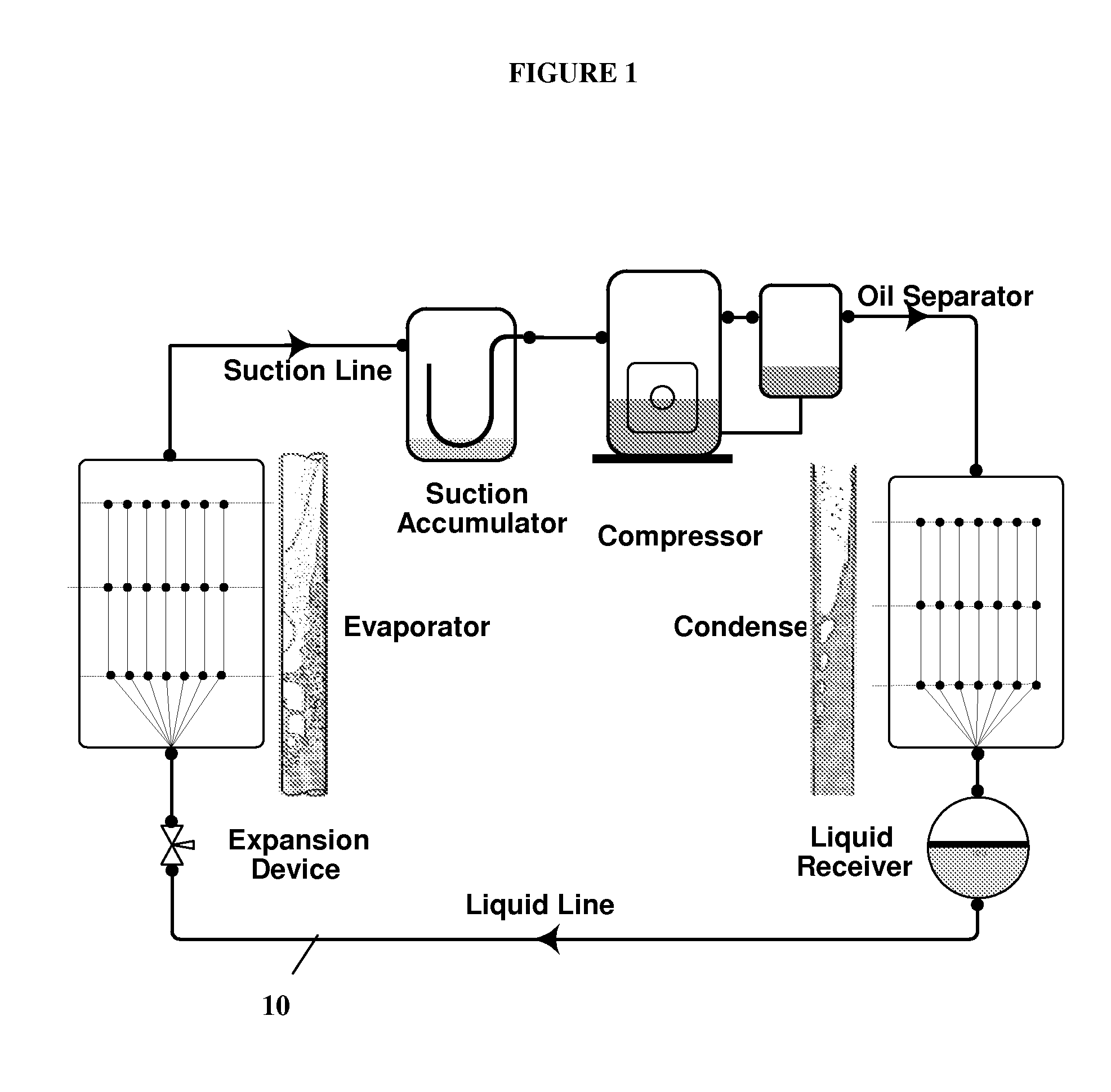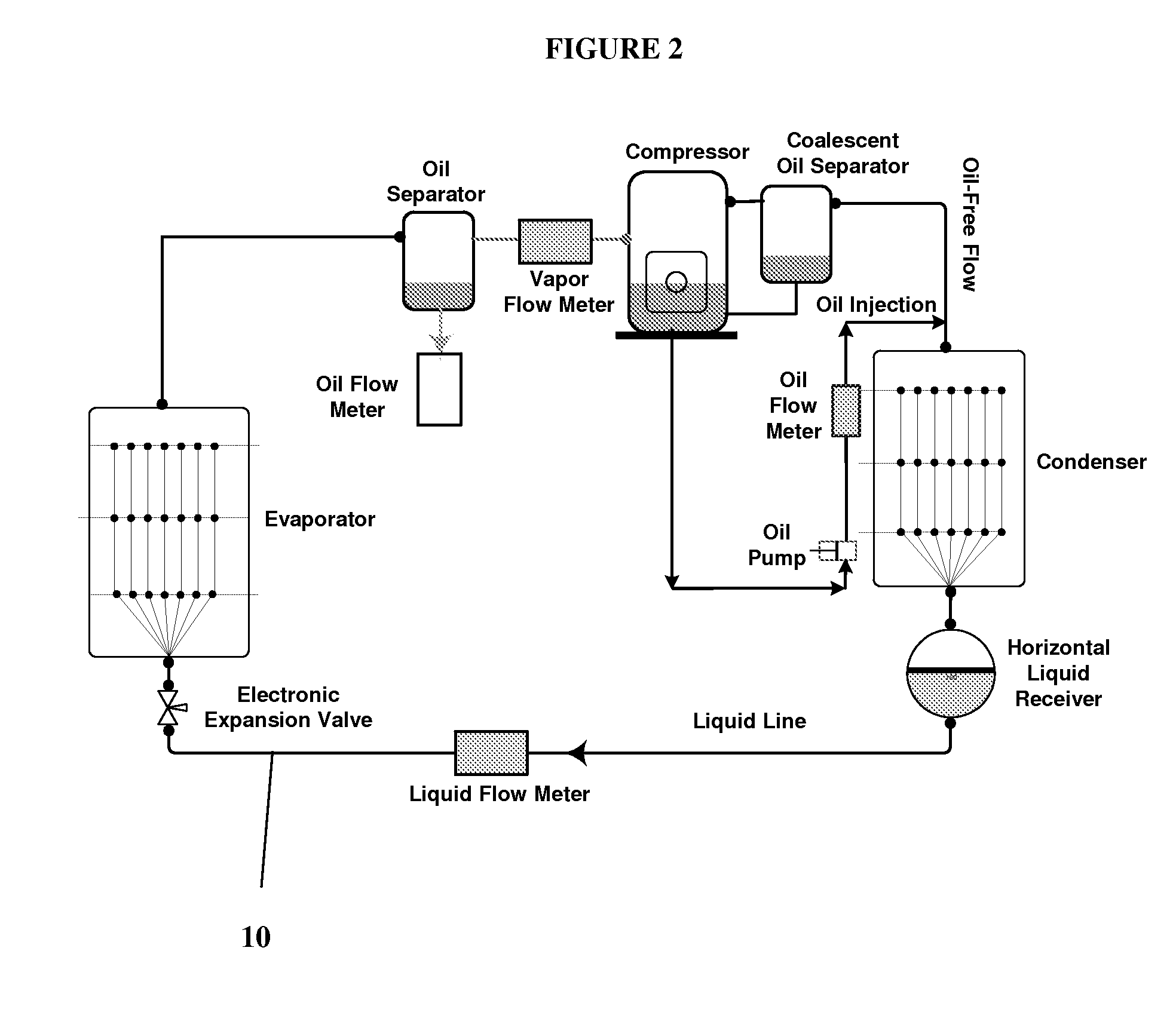Refrigerant compositions having a siloxane solubilizing agent
a technology of solubilizing agent and refrigerant, which is applied in the direction of lubricant composition, heat exchange elements, chemical instruments and processes, etc., can solve the problems of reducing system efficiency, high regulated use of cfcs and hcfcs, and affecting the stability of lubricants, etc., to achieve the effect of increasing the miscibility of an hfc in conventional lubricants, and unexpectedly and significantly increasing the mis
- Summary
- Abstract
- Description
- Claims
- Application Information
AI Technical Summary
Benefits of technology
Problems solved by technology
Method used
Image
Examples
example 1
Performance
[0037]This example demonstrates the thermodynamic properties of a HFC / HMDS and HFC / HMDS / HC blends.
[0038]Testing was performed in a refrigeration apparatus under typical operating conditions using a refrigerant test mixture and mineral oil (Nu-Calgon C-3 Refrigeration Oil). The test mixtures composition were as follows:
[0039]Blend 1: 96 wt. % of HFC (R407C) and 4 wt. % of HMDS
[0040]Blend 2: 97 wt. % of HFC (R407C), 2 wt. % of HMDS and 1 wt % of isobutane.
[0041]Testing was performed using a setup similar to the unit described in Report DOE / CE / 23810-71 “Study of Lubricant Circulation in HVAC Systems,” March 1995-April 1996 by Frank R. Biancardi et. al. (prepared for Air Conditioning and Refrigeration Technology Institute Under ARTI / MCLR Project No. 665-53100), which is incorporated herein by reference. In this case, commercial refrigeration system equipment was employed using a commercially available condensing unit and an evaporator for a walk-in freezer / cooler (see FIG. 1)...
example 2
Compatibility of Materials
[0045]Solubiliizing additives such as HMDS could introduce undesirable effects in certain components of the system. One of the most critical components is the expansion device because it is typically a flow restriction where deposition is possible. Standard industry tests are used to ensure no deposition and / or flow restriction is caused by the additives introduced in the system. The most commonly used test is the “Capillary Tube Clogging” test which consists of running a Standard refrigeration system using a capillary tube as a expansion device for a continuous period of 2000 h. Capillary tubes are inspected and mass flow measured using ASHRAE Std 28-1988 (Method of Testing Capacity of Refrigerant Capillary Tubes) at 500 h, 750 h, 100 h and at the end of the test (2000 h). Variations of ±3% are considered normal because they inside the range of experimental uncertainty of the measurements. Table 2 shows results obtained for two tests:
[0046]1. R407C using P...
example 3
System Test with HFC / HMDS / HC Blends
[0049]This example demonstrates that an HFC / HMDS / HC blend has better oil return properties in the liquid receiver of a refrigeration system as compared to a pure HFC. The intent of this experiment is to take advantage of the good solubility of high boiling hydrocarbons (e.g. Isobutane) but enhancing the solubility of the resulting blend by using HMDS as a low boiling solubilizing additive. These tests used the same equipment as described in Example 1, with the following modifications:
[0050]Two high-efficiency coalescent oil separators were added at the discharge of the compressor, so the stream after them was oil-free (below 50 ppm). A continuous oil injection system was designed to extract oil from the compressor sump and inject it at the inlet of the condenser, after the oil separators and before the liquid receiver (FIG. 2). This system comprises a high pressure oil pump, a metering valve and a mass flow meter, so we could impose a desired Oil C...
PUM
 Login to View More
Login to View More Abstract
Description
Claims
Application Information
 Login to View More
Login to View More - R&D
- Intellectual Property
- Life Sciences
- Materials
- Tech Scout
- Unparalleled Data Quality
- Higher Quality Content
- 60% Fewer Hallucinations
Browse by: Latest US Patents, China's latest patents, Technical Efficacy Thesaurus, Application Domain, Technology Topic, Popular Technical Reports.
© 2025 PatSnap. All rights reserved.Legal|Privacy policy|Modern Slavery Act Transparency Statement|Sitemap|About US| Contact US: help@patsnap.com



